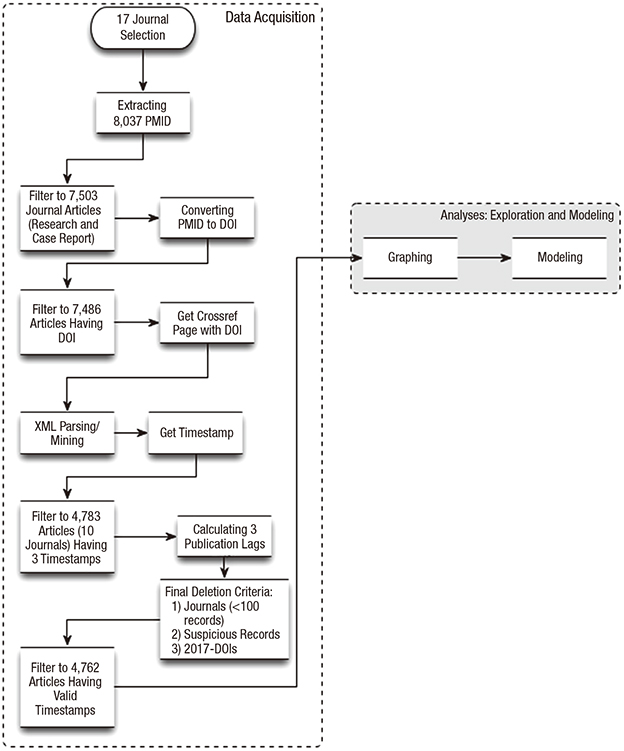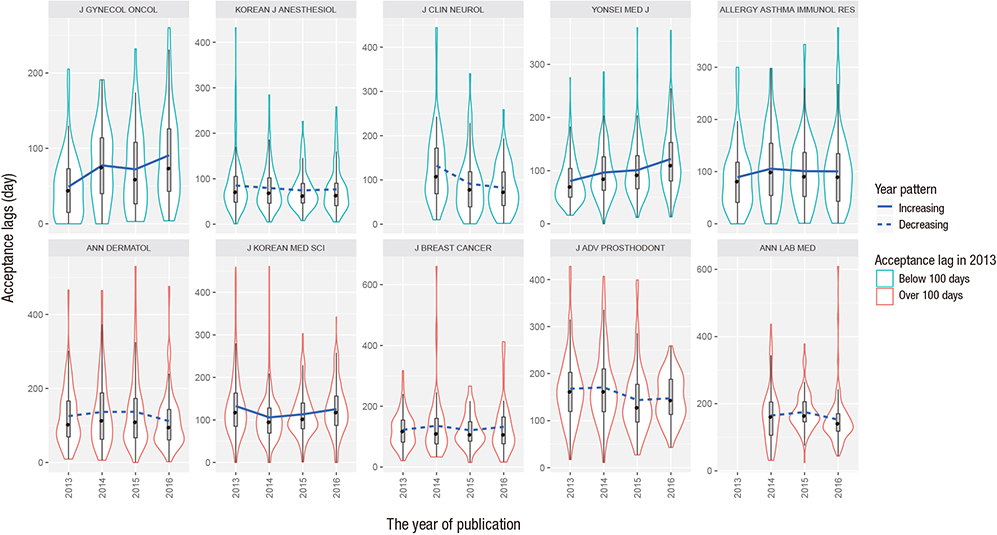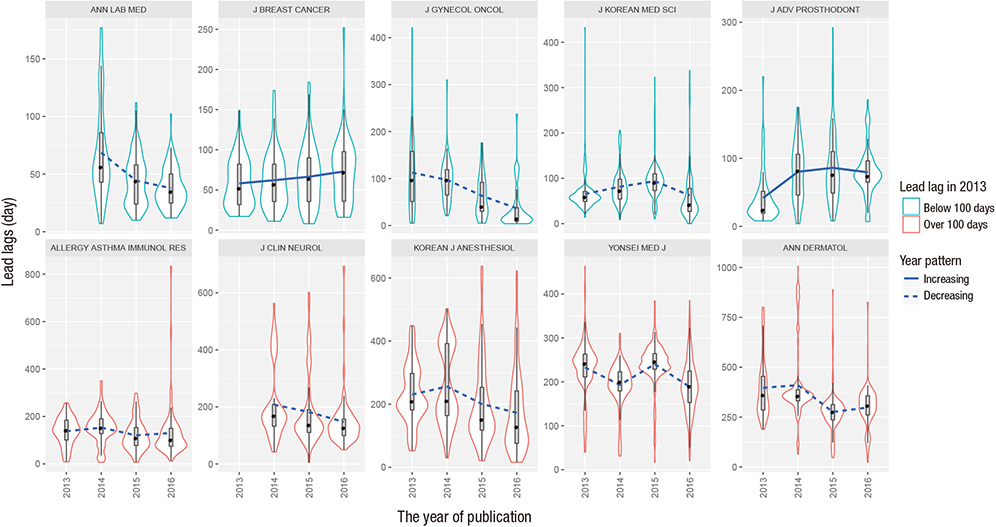J Korean Med Sci.
2017 Aug;32(8):1235-1242. 10.3346/jkms.2017.32.8.1235.
Publication Delay of Korean Medical Journals
- Affiliations
-
- 1Department of Anesthesiology, Dongguk University Ilsan Hospital, Goyang, Korea. ylee@dongguk.edu
- KMID: 2439455
- DOI: http://doi.org/10.3346/jkms.2017.32.8.1235
Abstract
- Publication lag is a determinant to journal efficiency that was not yet studied concerning Korean medical journals. To measure publication lag, we investigated the publication timestamps of 4,762 articles published by 10 Korean medical journals indexed in Scopus database, randomly selected from the KoreaMed Synapse since 2013. The total publication lag was 246.5 (Q1, Q3; 178.0, 347.0) days. The overall acceptance lag was 102.0 (65.0, 149.0) days. The overall lead lag was 123.0 (63.0, 236.0) days. The year of publication did not significantly affect the acceptance lag (P = 0.640), supposedly shortening it by about 1.4 (97.5% confidence interval [CI], −5.2 to 8.0) days/year, while the date affected the lead lag (P = 0.028), shortening it by about 12.9 (1.3 to 24.5) days/year. The Korean medical journals have reduced the total publication delay entirely by means of reducing the lead lag, not by reducing the acceptance lag.
Keyword
Figure
Reference
-
1. Björk BC, Solomon D. The publishing delay in scholarly peer-reviewed journals. J Informetrics. 2013; 7:914–923.2. Himmelstein D. Publication delays at PLOS and 3,475 other journals [Internet]. accessed on 31 December 2016. Available at http://blog.dhimmel.com/plos-and-publishing-delays/.3. Himmelstein D. The history of publishing delays [Internet]. accessed on 31 December 2016. Available at http://blog.dhimmel.com/history-of-delays/.4. Powell K. Does it take too long to publish research? Nature. 2016; 530:148–151.5. Else H. Scholar complains of how long it can take to publish interdisciplinary science [Internet]. accessed on 17 January 2017. Available at https://www.insidehighered.com/news/2016/12/02/scholar-complains-how-long-it-can-take-publish-interdisciplinary-science/.6. Lee Y. Time for something different: the Korean Journal of Anesthesiology commences EPUB ahead of print. Korean J Anesthesiol. 2016; 69:315–316.7. National Center for Biotechnology Information, U.S. National Library of Medicine. ID Converter API: the backend web service [Internet]. accessed on 6 January 2017. Available at https://www.ncbi.nlm.nih.gov/pmc/tools/id-converter-api/.8. Crossref (US). Open API of Crossref text and data mining for researchers [Internet]. accessed on 6 January 2017. Available at http://tdmsupport.crossref.org/researchers/.9. Bates D, Mächler M, Bolker B, Walker S. Fitting linear mixed-effects models using lme4. J Stat Softw. 2015; 67:i01.10. Lee Y. What repeated measures analysis of variances really tells us. Korean J Anesthesiol. 2015; 68:340–345.11. Scheer R. Further experiments in peer review [Internet]. accessed on 21 December 2016. Available at http://blogs.nature.com/ofschemesandmemes/2015/03/27/further-experiments-in-peer-review/.12. Nature Publishing Group.Research (GB). Peer review statements from 2014 author survey [Internet]. accessed on 21 December 2016. Available at https://figshare.com/articles/Peer_Review_statements_from_2014_Author_survey/1362178.13. Vosshall LB. The glacial pace of scientific publishing: why it hurts everyone and what we can do to fix it. FASEB J. 2012; 26:3589–3593.14. Hong ST. Peer review in 2014: more supports than neglects. J Korean Med Sci. 2015; 30:120–125.15. Gasparyan AY, Gerasimov AN, Voronov AA, Kitas GD. Rewarding peer reviewers: maintaining the integrity of science communication. J Korean Med Sci. 2015; 30:360–364.16. Gasparyan AY. Peer review in scholarly biomedical journals: a few things that make a big difference. J Korean Med Sci. 2013; 28:970–971.17. Alves-Silva E, Porto AC, Firmino C, Silva HV, Becker I, Resende L, Borges L, Pfeffer L, Silvano M, Galdiano MS, et al. Are the impact factor and other variables related to publishing time in ecology journals? Scientometrics. 2016; 108:1445–1453.
- Full Text Links
- Actions
-
Cited
- CITED
-
- Close
- Share
- Similar articles
-
- Open Access Publishing in India: Coverage, Relevance, and Future Perspectives
- Scientific Publication Speed of Korean Medical Journals during the COVID-19 Era
- Duplicate Publications in Korean Medical Journals Indexed in KoreaMed
- Korean Association of Medical Journal Editors (KAMJE) and the Current Status of KoreaMed and KoreaMed Synapse
- Impact Factors and Publication Times of Korean Plastic Surgery Journals





